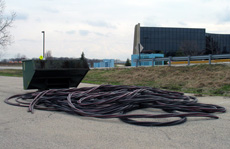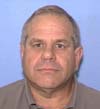|
Wed., March 28
THERE WILL BE NO Fermilab ILC R&D Meeting THIS WEEK
3:30 p.m.
DIRECTOR'S COFFEE BREAK - 2nd Flr X-Over
4:00 p.m.
Fermilab Colloquium - 1 West
Speaker: C. Tan, Brown University
Title: Diffractive Scattering and Gauge/String Duality
Thurs., March 29
1:00 p.m.
ALCPG ILC Physics and Detector Seminar - West Wing WH-10NW
Speaker: G. Mavromanolakis, Fermilab
Title: Calice Testbeam Program
1:30 p.m.
Presentations to the Physics Advisory Committee - Curia II
Agenda
THERE WILL BE NO THEORETICAL PHYSICS SEMINAR THIS WEEK
3:30 p.m.
DIRECTOR'S COFFEE BREAK - 2nd Flr X-Over
THERE WILL BE NO ACCELERATOR PHYSICS AND TECHNOLOGY SEMINAR TODAY
6:00 p.m.
UTeV Seminar - 1 West
Speaker: G. Gollin, University of Illinois
Title: The International Linear Collider: A Detector
Physicist Describes Accelerator Physics to
Anyone Who Will Listen
Click here for NALCAL,
a weekly calendar with links to additional information. |
Wednesday, March 28
-Vegetable beef soup
-Carb cakes
-Smart cuisine: Grilled salmon
-Country fried steak w/pepper gravy
-Beef and Cheddar Panini w/sauteed onions
-Assorted sliced pizza
-Cavatappi pasta with Italian sausage and tomato ragu
Wilson Hall Cafe Menu |
|
Wednesday, March 28
Lunch
-Stuffed fillet of sole
-Green rice
-Steamed asparagus
-Apple raisin turnovers
Thursday, March 29
Dinner
-Clam chowder
-Filet mignon
-Vegetable of season
-Potato dauphinois
-Chocolate soufflé w/frangelico cream anglais
Chez Leon Menu
Call x4598 to make your reservation. |
|
|
Two arrested when alert
employee helps foil theft

Two men were arrested yesterday for the alleged theft of 320 pounds of scrap metal from this dumpster.
An alert and clear-thinking employee helped prevent the theft of scrap metal from a dumpster near the Feynman Computing Center on Tuesday morning, leading to the arrest of two persons on the Fermilab site. The two had allegedly loaded a quantity of scrap aluminum from a storage bin into their van at around 9 a.m., but they were unaware that they had been spotted.
A lab employee pulling into the parking lot saw what he described as a "beat-up white minivan." He also saw a man wearing a hooded jacket or sweatshirt pulling metal out of the storage bin and piling it into the van, while appearing to look around furtively several times. The employee called Fermilab Security at ext. 3131 on his cell phone to report the suspicious activity, but his view of the van's license plate was blocked. Remaining in his car and on the phone while the van started to pull away, the employee was then able to report the plate number along with the direction the van was heading. The security dispatcher alerted Fermilab Security patrols and called local law enforcement.
A security mobile unit stopped the van on Pine Street, just before it left the site. The van was occupied by two adult males and one juvenile male. Batavia City Police responded and backed up lab security until the arrival of Kane County Sheriff Department Deputies. Staff from the lab's Business Services Section removed the aluminum from the van, then weighed it and inspected it. The metal weighed 320 pounds and was worth $176 at scrap value. The employee who made the original phone call was summoned to identify the vehicle and the suspects. The Sheriff's Deputies jailed the two adults, one of whom was the father of the juvenile. The Sheriff's Deputies then allowed the father to place a call to relatives, who came to the scene to take care of the juvenile.
Fermilab Security has been working with groups across the lab in efforts to prevent thefts of scrap metal, including suggestions for individual employees to take responsibility for making sure that material is secured well. Bill Flaherty, head of lab security, said there had been a similar suspicious incident with no arrests the previous week, with several other incidents reported over the last six months. Even with additional security procedures in place, individual employees who are alert for suspicious activity can sometimes be the most effective resources.
"It was the right thing to do," the employee said. "I know times are tough, and maybe these were people who are struggling, but this was not the right way for them to go about it. I just hope they will all learn a lesson."
--Mike Perricone
|
John Santic
 |
| John Santic |
Fermilab engineer John Santic passed away unexpectedly on Saturday, March 24.
He was 51 years old.
At the time of his death, Santic worked with the Conventional Facilities Siting group for the ILC. His efforts were fundamental to the completion of the ILC Reference Design Report and the associated cost estimate presented in Beijing in February. "John was an excellent engineer, a friend and a valuable member of the CFS team," said CFS Americas Regional Team Leader Vic Kuchler. "He will be sorely missed."
Santic has been associated with Fermilab for 16 years. In 1991, he started as a consultant on the Main Injector and NuMI projects. Over the next few years, Stanic also worked on BTeV and provided much-needed high-voltage electrical support to the FESS Engineering Group. Just after the ILC Snomass Conference in August of 2005, he joined the International Linear Collider project. He became a full-time Fermilab employee on October 9, 2006.
Santic is described by colleagues as a hard worker who was good at dealing with the massive challenges of an international project. He was also fun to be around. "John was well-liked and able to interact with other members of the ILC collaboration to get the most difficult jobs done," said Kuchler. "We will miss him dearly."
Friends may call at the Burns-Kish Funeral Home, 8415 Calumet Ave., Munster, Ind., on Wednesday, March 28, from 4:00 to 8:00 p.m. Funeral services will be held Thursday, March 29, at 9:15 a.m. at the funeral home followed by a mass. More information is here.
European Space Agency,
March 27, 2007:Magnetic fields get reconnected in turbulent plasma too, Cluster reveals
Using measurements of the four ESA's Cluster satellites, a study published this week in Nature Physics shows pioneering experimental evidence of magnetic reconnection also in turbulent 'plasma' around Earth.
Magnetic reconnection - a phenomenon by which magnetic fields lines get interconnected and reconfigure themselves - is a universal process in space that plays a key role in various astrophysical phenomena such as star formation, solar explosions or the entry of solar material within the Earth's environment. Reconnection has been observed at large-scale boundaries between different plasma environments such as the boundary between Earth and interplanetary space. Plasma is a gas composed of charged particles.
Read More
|
|
|
Maintaining momentum
Today's column is written by Jim Strait, head of the Particle Physics Division
 |
| Jim Strait |
The remarks that DOE Under Secretary for Science Ray Orbach made to HEPAP last month about the proposed ILC, to the effect that "the schedules will almost certainly be lengthier than the optimistic projections," and that "building the machine could take us well into the mid-2020s," have raised understandable concerns within the HEP community.
I view this not as a statement of what will happen, but as a reminder -- based on the experience of other large international science projects, most notably the large fusion physics project ITER -- of how difficult it may be to launch such a complex venture. Our challenge is to maintain our momentum toward the ILC, and work with our colleagues from around the world to fully develop technological and engineering solutions needed for the ILC. By strengthening and deepening our world-wide collaborations, we can help lay the foundation for the international structures that will be needed to build the ILC.
Within the Particle Physics Division, the recognition that the ILC may take longer to realize than the "optimistic projections" does not change the approach to detector R&D outlined in my previous column. We must continue to grow our programs to explore technologies for ultra-thin, high-precision pixel detectors, and to understand which of the hadron calorimetry methods holds the most promise for precision measurements of particle jets.
We must also continue and expand our engineering work, addressing how the different detector elements can be integrated into a complete experiment that retains the precision inherent in the individual systems. And we must to continue to support both the user community and our own program, by developing the infrastructure needed for R&D on state-of-the-art detector technologies, and by running a world-class test beam program.
Nagaitsev captures award
for electron cooling work
Sergei Nagaitsev of Fermilab's Accelerator Division, and Yaroslav Derbenev of Thomas Jefferson National Accelerator Facility have won the 2007 U.S. Particle Accelerator School Prize for Achievement in Accelerator Physics and Technology. The awards will be presented at the 2007 Particle Accelerator Conference held in Albuquerque, New Mexico this summer.
Nagaitsev was cited for his outstanding scientific leadership in the demonstration of non-magnetized relativistic electron cooling of hadron beams to improve collider luminosity. Derbenev was recognized for his seminal contributions to the theory of beam polarization in accelerators and its control with "Siberian snakes," the theory of electron cooling and the inventions of "round-to-flat" beam optics transformations and novel six-dimensional muon cooling schemes.
For more details visit the U.S. particle accelerator school web site.
|
|
Free Osteoporosis Screening, April 4
Fermilab will offer a free heel-scan osteoporosis screening on
April 4, from 7:30 a.m. to 10:45 a.m. on the
15th Floor of Wilson Hall in the NW Conference Room. The heel scan is open to both men and women, and results are immediate. If you have had fractures or surgery on both feet, or if you took advantage of the last Fermilab Screening, you will not be able to participate in this screening. You can find instructions and more information on the ES&H homepage.
String Theory: Brian Greene and Lawrence Krauss Debate
Is all of nature really made up of tiny bits of vibrating strands of energy? The controversial string theory could bridge the gap between classical and quantum physics, and could explain some of the universe's biggest questions, such as the origin of space and time. Critics, however, say the theory has no empirical foundation. The DOE Office of Science and the Smithsonian Institution will co-sponsor a debate between string theory proponent Brian Greene and skeptic Lawrence Krauss tonight at 7:00 p.m. at the National Museum of Natural History in Washington, D.C. The debate will be moderated by University of Chicago cosmologist Michael Turner. Call 202-357-3030 or visit the website for details.
Fermi Kyuki-Do Martial Arts Class
Kyuki-Do classes will start on April 9. This martial art combines the strikes of Taekwon-Do, the throwing and grappling techniques of Judo and Jujitsu, the joint locks of Hapki-Do, and the practice of Kobudo (traditional weapons). Classes are held on Monday and Wednesday from 5 - 6 p.m. at the Recreation Facility in the Village. Teacher Bruce Worthel will focus on a practical self-defense that can be used by women or men. You will learn kicks, blocks, hand techniques, throws, pins, self-defense, and forms that will teach you balance, power, and grace. Register through the Recreation Office; classes cost $45 per 6-week session. You must be a member of the recreation facility to join.
Upcoming Activities |
|
|
|
 |
| |
|